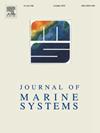根据SAR和光学卫星资料的Iokanga河羽流动力学
IF 2.5
3区 地球科学
Q2 GEOSCIENCES, MULTIDISCIPLINARY
引用次数: 0
摘要
Iokanga河是科拉半岛最大的河流之一,流入巴伦支海的西南部和白海的北部。从Iokanga河和其他地区河流流出的水形成了一个新鲜的沿海水团,向东延伸成为沿海摩尔曼斯克流。然而,作为河流流量和海岸水团之间过渡形式的小河流羽流的动力学和变异性在该地区仍未得到充分的研究。基于高分辨率合成孔径雷达(SAR)和光学图像,研究了Iokanga羽流在无冰期的空间特征,并对其动力学进行了分析。该研究提供了外部水文气象因子及其在不同时间尺度上对羽流位置变化的贡献的评估。值得注意的是,建立了潮流对羽流日内变化形成的关键贡献,这对于北冰洋大多数河流羽流来说是不典型的。目前的工作还描述了Iokanga羽流的亚中尺度涡旋的主要特征,并分析了其形成机制。所获得的结果对于理解巴伦支海西南部沿海水团形成的过程以及确定河流传播污染物的潜在途径至关重要。从方法学的角度来看,这项工作可能对利用SAR和光学卫星数据在沿海地区研究小河流羽流的特征有价值,这些地区很少被现场测量覆盖。本文章由计算机程序翻译,如有差异,请以英文原文为准。
Dynamics of the Iokanga River plume according to SAR and optical satellite data
The Iokanga River is one of the largest rivers of the Kola Peninsula, discharging into the southwestern part of the Barents Sea and the northern part of the White Sea. The outflows from the Iokanga River and other regional rivers form a freshened coastal water mass, which extends eastward as the Coastal Murmansk Current. However, the dynamics and variability of small river plumes, which represent a transitional form between river discharge and the coastal water mass, remain practically unexplored in this region. In this study, based on high-resolution synthetic aperture radar (SAR) and optical images, the spatial characteristics of the Iokanga plume were examined and its dynamics were analyzed during the ice-free period. The study provides an assessment of external hydrometeorological factors and their contribution to the variability of the plume positions on various time scales. Notably, a key contribution of tidal currents to the formation of the intra-daily variability of the plume was established, which is nontypical for the majority of river plumes in the Arctic Ocean. The current work also describes the main characteristics of submesoscale eddies in the Iokanga plume and analyzes the mechanisms of their formation. The obtained results are crucial for understanding the process of coastal water mass formation in the southwestern Barents Sea and for identifying potential pathways for river-borne contaminant spread. From a methodological perspective, this work may be valuable for studying the characteristics of small river plumes using SAR and optical satellite data in coastal regions, which are poorly covered by in situ measurements.
求助全文
通过发布文献求助,成功后即可免费获取论文全文。
去求助
来源期刊

Journal of Marine Systems
地学-地球科学综合
CiteScore
6.20
自引率
3.60%
发文量
81
审稿时长
6 months
期刊介绍:
The Journal of Marine Systems provides a medium for interdisciplinary exchange between physical, chemical and biological oceanographers and marine geologists. The journal welcomes original research papers and review articles. Preference will be given to interdisciplinary approaches to marine systems.
 求助内容:
求助内容: 应助结果提醒方式:
应助结果提醒方式:


